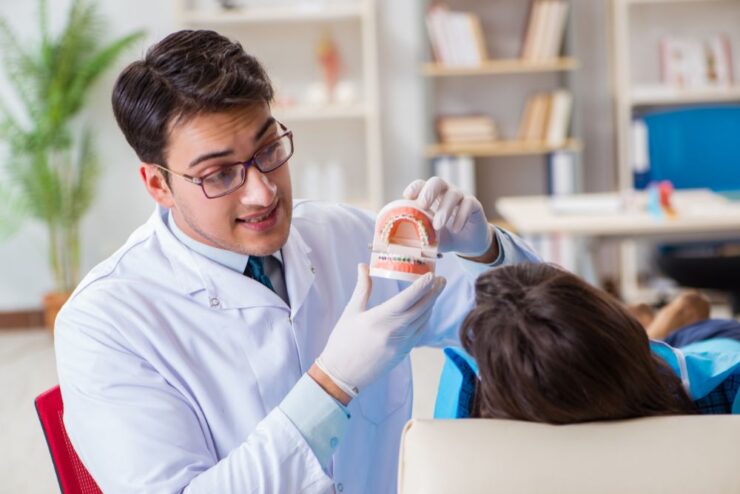At the first appointment, you will be able to meet the staff as well as the orthodontist before your child sees the orthodontist. Upon arrival, your orthodontist will escort your child and you to an exam area where they will perform your orthodontic exams. It may be necessary for the orthodontist to illuminate overhead to be able to see into your child’s mouth and examine them closely. You’ll have your child sit in a dental chair with comfortable neck support.
To view your child’s upper teeth correctly, using a mirror will allow your orthodontist to move your child’s cheeks so they can see behind the upper teeth more clearly. If the orthodontist asks your child biting down, it will be so that he or she can observe the way the upper and lower teeth communicate with each other as well as the position of the top and bottom jaws. For more information, contact a trusted and experienced orthodontist or visit drmcsurdy.com.
What Should Be The First Orthodontic Appointment For My Child?

By the time a child reaches the age of seven, they should undergo an orthodontic examination. It will be possible for the orthodontist to recognise orthodontic problems in the early stages of a child’s development since they possess a mixture of permanent teeth and baby teeth at that age.
If you notice that something is off in your child and you don’t want your child to put it off until they are seven years old or that your dentist has recommended that they get the checkup, you don’t have to let them wait until they are seven years old to get their checkup. It is still okay to have your child checked by an orthodontist if they are eight or older.
During this appointment, the orthodontist will listen to parental concerns and answer their questions regarding whether orthodontic treatment is necessary, when to begin, and what recommended it is. Your orthodontist may recommend periodic visits if no problems are found. Regular visits will ensure that permanent teeth are forming at the right time and that the child’s growth and development are being monitored.
What Will Happen If The Visit Reveals An Orthodontic Problem?
Orthodontists will discuss when and what type of orthodontic treatment your child should receive. In some instances, early intervention is in the child’s best interest (as long as a few baby teeth remain). It is essential to recognise that everyone has different problems, so some children may benefit the most from treatment if, for example, they wait until nearly all their teeth have erupted before starting treatment. It is up to the individual to determine the best course of action for themselves as well as the group.
The orthodontist may recommend that you wait a while and see how your child develops and grows. Treatment can then occur during predictable growth phases when the orthodontist sees that your child will get stronger and healthier as time goes on. As a result, orthodontists may obtain results that might be impossible when jaws and faces are wholly developed, which may be beneficial for some patients.
What Can Be Done For A Child With Special Needs?
First, clearly explain what your child’s unique needs are at the first appointment. As a result, your doctor and the rest of the staff can be prepared for your child’s visit so that they are comfortable and makes the visit as pleasant as possible for your child. The doctor will inform you if your child has special needs that they will be unable to meet when you make an appointment in case your child has any special requirements. You can get a suggestion from your orthodontist about someone who can accommodate your child’s unique needs if they suggest one.
What Happens During An Orthodontist’s Visit?

The first time you go to the orthodontist for the first time, you’re likely to see an office that looks very similar to the office where you’re going to your dentist. A technician or assistant will be sitting in front of you, taking X-rays or computer pictures of your mouth and teeth while you sit in the dentist’s chair. Through X-rays and photos, the orthodontist can determine the position of your teeth and whether or not any teeth are not yet present.
Alternatively, the technician or orthodontics specialist may use a tray of gooey material and press it into the back and front of your teeth to make a mould (or impression) of your teeth. A perfect image of the shape and size of the teeth will be left behind after the mould is removed from the mouth. Orthodontists use moulds to help decide which method of straightening your teeth will be most effective.
It would be best if you went to the dentist to have your teeth, mouth, and jaws examined by the orthodontist. If they ask if you have problems chewing or swallowing or whether you experience jaw clicking or popping when you open your mouth, they may ask you to open wide or bite your teeth together. You may receive a letter from your orthodontist telling you and your parents that your teeth and jaws are okay, or they may recommend that you begin treatment.
How Do Braces Work?
By putting steady pressure on the teeth, braces correct the way your teeth line up and eventually move them into a more straight position by putting constant pressure on them. After wearing braces, you may need a retainer to prevent your teeth from drifting out of place. This device applies pressure to your teeth and holds them in place.
You will visit the orthodontist at least once every few weeks once your braces are on. In some cases, the orthodontist may check if your braces are properly placed during your visit to ensure they are in their proper place. In other cases, the brace may need to be adjusted at another stop to move the teeth into a more suitable position. In addition, your orthodontist will likely show you how to wear rubber bands to change how your teeth line up by stretching them between two teeth.
Final Words

If your dentist or parent sees a problem with your teeth or jaw, they may recommend it. An orthodontist may be consulted by a kid who is unhappy with how the teeth look. An orthodontist treats children with problems with their teeth, jaw growth, or tooth development, including crowded or overlapping teeth. A tooth decayed tooth, a baby tooth lost too early, an accident or a habit such as thumb sucking can cause these problems. Genes and inheritance can also cause these problems, so they can run in families.

